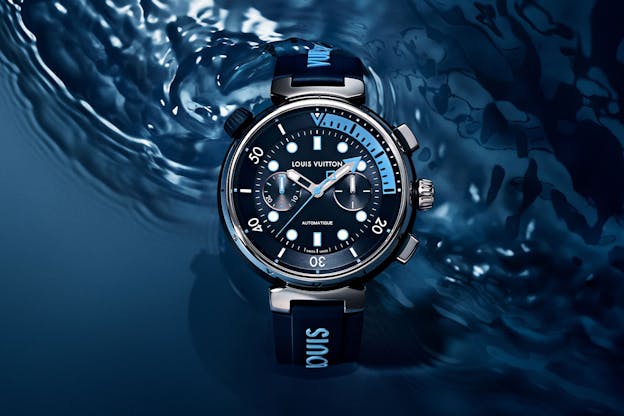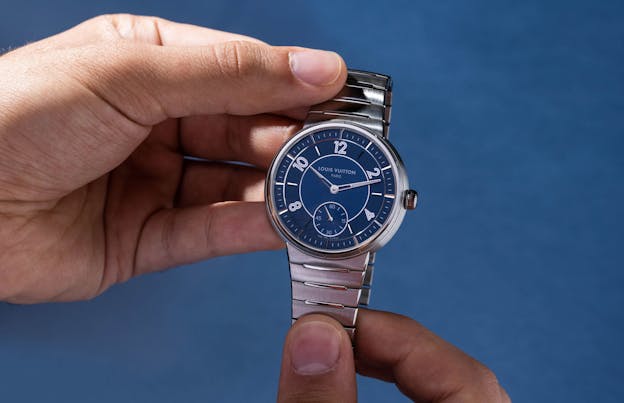The Louis Vuitton Tambour, In Steel
A steel drum serenade for the wrist.
For every major fine watchmaking brand, there is a design which is so strongly identified with it that it becomes more or less synonymous with the identity of the brand itself. To what degree this actually reflects what the company makes varies from brand to brand – the Royal Oak dominates Audemars Piguet’s modern design language in a way that the Nautilus does not dominate Patek’s, for instance, but in both cases, to see the watch is to see the brand.
For Louis Vuitton, that design is the Tambour, the drum-shaped case (“tambour” means “drum” in French) which Louis Vuitton has used for everything from diver’s watches to complex regatta choreographs, to sophisticated unique complications like the Spin Time (another brand icon) and metiers d’art pieces like the GPHG Audacity award-winning Carpe Diem automaton watch, which is one of several highly complex automaton watches Louis Vuitton has constructed in the Tambour case.

However, one missing category of modern wristwatch among all the enormous range of Tambour watches, has been a modern integrated bracelet daily wear sports watch. Today, however, Louis Vuitton has begun a new chapter in the history of the Tambour with the introduction of a Tambour watch in a variation of the classic case design, specifically designed to match with an integrated bracelet – somewhat reminiscent of the lug-less round dress watches of the past in which the strap was attached to a recess hidden under the edge of the case. In keeping with the identity of the watch as a new fundamental design, this new integrated bracelet Tambour watch is called just that, and only that: Tambour.

The two new versions of the watch are offered in 40mm x 8.3mm stainless steel cases, with Super-Lumi-Nova-filled hands, and even numbered numerals and indexes in the inner hour track. A minute track runs around the outer edge of the dial, which sits close to the edge of the case thanks to the thin bezel. Louis Vuitton has, somewhat unusually for a modern steel sports watch, opted for a small seconds display in a subdial at 6:00, which gives the watch a slightly more formal feel in keeping with the design-forward identity of the Tambour case, and the history of the Tambour design at Louis Vuitton.
The tapering integrated bracelet has an invisible three-blade clasp, and attaches to the case through recesses cut into the case flank. The end-pieces of the bracelet are secured with screws running through the end-links and into the bottom of the case itself and the overall impression one gets of this critical transition is one of streamlined structural integrity. The case is water resistant to 50 meters.

The Tambour in steel is powered by a new movement: the micro-rotor automatic caliber LFT023, which was designed at La Fabrique du Temps and which will be manufactured by their movement partner, specialist constructor Le Cercle des Horlogers. The movement is very traditionally proportioned, at 30.6mm x 4.2mm, with a 22k rose gold rotor and holds 50 hours of power reserve. It is also a certified chronometer, with the control performed by the Geneva Chronometric Observatory under the auspices of Timelab (the Geneva Observatory was one of the major European centers for observatory chronometer rating and competitions).
History Of The Tambour Design
The new steel Tambour is a design distinct from earlier versions of the case, which in general sport a much taller case profile which lends itself to complicated watchmaking. The first group of Tambour watches were shown in the Japanese market, in 2002, although the basic idea of drum-shaped watches is about as old as watchmaking itself – drum-shaped portable clocks which straddled the transition between watches and clocks during the 17th century.

The first complication to be placed in a Tambour case was a tourbillon – the Tambour Tourbillon Monogram of 2004. In 2009, Louis Vuitton launched the Tambour Spin Time. The Spin Time, designed by Michel Navas and Enrico Barbasini, is a unique kind of jump hour watch and it has become a signature timepiece and complication for LV, in the same way that the the Tambour had by then already become a signature design overall.

The basic shape of the Tambour case lends itself to complications, with its tall, sloping sides and pronounced taper from the caseback to the bezel – the wider base also means that even if the watch is relatively thick, its center of gravity will be lower and it will sit more comfortably on the wrist than you’d expect.

The shape of the case is also a good foundation for diver’s watches, as shown by the success of the Tambour Street Diver collection. For the new Tambour in steel, however, the case was modified to keep its assertive three-dimensionality while at the same time making it more versatile for every day wear; this is most obvious in the relative slimness of the case, at 8.3mm thick, which is the exact thickness of the Patek 5711.
Daily Drummer
The Tambour in steel is clearly intended to be a versatile, reliable every day watch, but it also retains a lot of the idiosyncratic identity of the Tambour design; it’s not a substitute for or an imitation of any other watch in its category.

The Tambour in steel stands out from the rest of the collection, including the Street Diver, in a number of ways. First of all, it is a very discreet take on the Tambour design, although this is relative to its predecessors, the majority of which are very extroverted complications. Secondly, it is aimed at an entirely different customer. If you’re asking who this watch is for (which is always a relevant question to ask; it is easy to object to a watch if you expect it to be something that it’s not) I think it’s for someone who wants a daily wear integrated bracelet sports watch from a company with real history with the design, who is also looking for something slightly away from a lineup of the usual suspects.

Thirdly and perhaps most interestingly of all from a design and experiential perspective, this is not like anything else that Louis Vuitton has ever done; it’s a Tambour, but reinterpreted for a very different scenario than most of the unapologetically exotic complications that have been the mainstay of the Tambour family almost since its inception. A Spin Time or synthetic sapphire-cased tourbillon, is a watch that creates a very particular sense of occasion.

What you want from a daily-wear watch in a steel Tambour case, however, is versatility combined with a specific sense of style. In this day and age you also want something that expresses some individuality, which has become harder and harder to get in the very crowded integrated bracelet luxury sports watch world. What you get from the steel Tambour is exactly that – an exercise in style and practicality that has an element of self-confidence to it, and which says that the watches you pick, you choose to please your own tastes, not someone else’s.
For a look inside Louis Vuitton La Fabrique du Temps, check out our conversation with Tim Mosso, Enrico Barbasini, Michel Navas, and Jean Arnault.
The Louis Vuitton Tambour in steel, references W1ST10 (grey dial) and W1ST20 (blue dial). Case, stainless steel, 40mm x 8.8mm, Super-LumiNova on hands and numerals, sapphire crystals front and back with 50M water resistance. Movement, caliber LFT023, 30.6mm x 4.2mm, 22k gold micro-rotor with 50 hour power reserve, running in 31 jewels at 28,800 vph. Certified chronometer; chronometric control by the Geneva Chronometric Observatory. Price at launch, $18,500. For more on Louis Vuitton watches, visit LouisVuitton.com.


